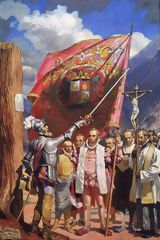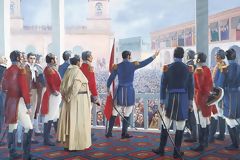By the early 15th century, the Inca Empire had extended its influence over a vast territory, from modern-day Colombia to Chile. This highly organized civilization, centered in the capital city of Cuzco, was known for its complex social structure, extensive road networks, and agricultural terraces. However, the arrival of Spanish conquistadors in the early 16th century would radically alter the region's fate.
In 1526, Spanish explorer Francisco Pizarro first landed on the coast of Peru. Enticed by tales of the Inca Empire's wealth, he returned to Spain to obtain royal approval for the conquest. In 1532, Pizarro returned with a small group of men determined to take control of the empire.
The timing of their arrival coincided with a civil war between two Inca brothers, Atahualpa and Huascar, who were battling for the throne. Atahualpa emerged victorious but was soon captured by Pizarro during the ambush at Cajamarca. Despite paying a ransom in gold and silver, Atahualpa was executed in 1533, marking the beginning of Spanish rule in Peru.
 In 1535, Pizarro founded the city of Lima, which quickly became the capital of the Viceroyalty of Peru. This city became the heart of Spanish power in South America, housing the main administrative, religious, and commercial institutions of the Spanish colonial empire.
In 1535, Pizarro founded the city of Lima, which quickly became the capital of the Viceroyalty of Peru. This city became the heart of Spanish power in South America, housing the main administrative, religious, and commercial institutions of the Spanish colonial empire.
The Viceroyalty of Peru encompassed most of South America, with Lima as its core. With its port in Callao, Lima became a vital hub for transatlantic trade, with ships carrying gold, silver, and other natural resources to Spain. Additionally, Lima became a major religious center, with the construction of numerous churches, monasteries, and religious institutions, including Catholic missions aimed at converting the indigenous population.
Spanish settlers quickly established an economic system based on the exploitation of Peru's natural resources. The most important of these were the silver mines in Potosí, located in present-day Bolivia, which became one of the Spanish Empire's primary sources of wealth.
The exploitation of these resources relied heavily on indigenous labor. The **encomienda** system was introduced to grant lands and indigenous workers to Spanish settlers. In exchange for their labor, the settlers were supposed to "protect" and convert the indigenous population to Christianity. However, in practice, this system often resembled slavery.
In addition to mineral extraction, Peru became an important agricultural producer. Spanish colonists set up plantations to cultivate sugarcane, cocoa, and maize. These large estates, known as **haciendas**, became sites of intensive labor, where both indigenous and African enslaved people were forced to work under harsh conditions.
Spanish rule was not established without resistance. From the beginning of colonization, the Incas attempted to regain control of their lands. Manco Inca, initially appointed as a puppet ruler by the Spaniards, rebelled in 1536. He retreated to the region of Vilcabamba, leading a guerrilla war against the colonists for nearly 40 years until his last successor, Tupac Amaru, was captured and executed in 1572.
Colonial rule saw numerous uprisings, the most famous being the rebellion of Túpac Amaru II in 1780. A descendant of the last Inca emperors, Túpac Amaru II led a major uprising against Spanish abuses. Though it was brutally suppressed, he remains an iconic figure in the struggle for indigenous rights.
 By the 18th century, the Spanish crown, under the Bourbon dynasty, sought to reform colonial administration to increase efficiency and revenue for the motherland. These **Bourbon reforms** aimed to centralize power and impose new taxes on Spanish settlers. They were met with resistance and caused tension between the Spanish settlers, the indigenous populations, and the crown.
By the 18th century, the Spanish crown, under the Bourbon dynasty, sought to reform colonial administration to increase efficiency and revenue for the motherland. These **Bourbon reforms** aimed to centralize power and impose new taxes on Spanish settlers. They were met with resistance and caused tension between the Spanish settlers, the indigenous populations, and the crown.
At the same time, Enlightenment ideas and revolutions in North America and France inspired new notions of independence. By the early 19th century, economic conditions had worsened, and figures like José de San Martín and Simón Bolívar emerged to lead the fight for independence in Peru.
In 1820, José de San Martín landed on the Peruvian coast with his troops. In 1821, he entered Lima and declared Peru's independence, though the Spaniards continued to control certain regions. It wasn't until 1824, after the decisive Battle of Ayacucho, that Peruvian independence was finally secured thanks to Simón Bolívar's leadership.
The victory at Ayacucho marked the end of Spanish rule in South America. Peru then entered a new era marked by internal political struggles and the quest for stability after several centuries of colonial rule.